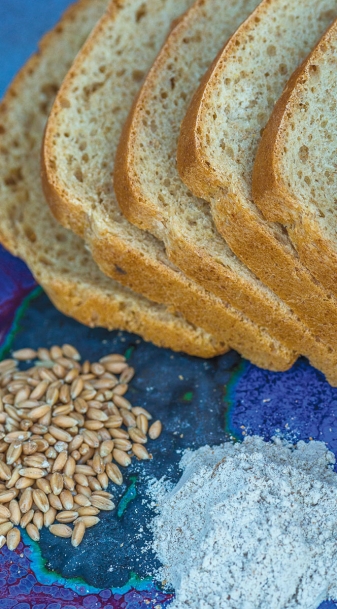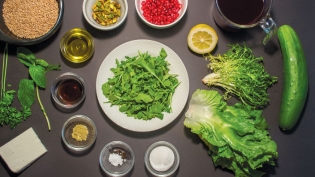A New Life for Old Seed
Building a market for ancient grains
Glorious, golden grain is waving again over much of Idaho this fall. Of the 50 states, Idaho is number six in wheat production and number three in barley. But one class of grains is barely present, despite growing demand across the US.
Popularly labeled “ancient grains,” their names roll off your tongue like poetry: emmer, farro, spelt, teff, quinoa, einkorn, Kamut®, amaranth, freekeh, millet. They offer flavor, nutrition and versatility unique from modern wheat. Diverse and distinct, each of these grains at one time nourished entire cultures.
Now, sparked by curiosity and potential markets, a small group of entrepreneurial and inventive farmers in Idaho are growing ancient grains, though not without hardships. Just starting out is tough, because finding seed for ancient grains is not easy.
John Skinner, a farmer in New Plymouth who grows seed for lettuce and radishes, became interested in growing einkorn, the oldest known strain of wheat, for its nutty flavor and nutritional value. Because of demand, he couldn’t obtain seed for quite a while until the University of North Dakota supplied him with a handful. Each year he has expanded what he’s planted, and saved his own seeds. He’s up to an acre this year and his einkorn is flourishing, which is good news for increased expansion next year.
Another complication to raising ancient grains is their unique physical structure compared with modern wheat. Beth Rasgorshek, a wheat farmer who owns Canyon Bounty Farm in the Treasure Valley, tried her hand with emmer, an old form of wheat, but stopped because harvesting was so difficult. Unlike modern wheat, emmer and most other ancient grains have hulls that must be removed before eating. “Modern combines cannot remove the hull—it must be done by hand or different equipment,” Rasgorshek said, adding, “Ancient grains often lack the straw [stem] strength to withstand a strong wind. But if you can successfully grow it, it adds tremendous flavor to bread.”
Once an efficient method of harvest is attained, farming these grains on a wider scale becomes possible. A few years ago, quinoa blew in from Bolivia as a mega-nutritious and non-gluten grain, creating high demand. Quinoa has not yet found a foothold in Idaho, but Jeremiah Clark of Clark Seeds in Idaho Falls would like to change that. His interest began three years ago after his son was diagnosed with celiac disease and prohibited from eating gluten. This year he’s planted 400 acres of quinoa using 14 to 15 growers in eastern Idaho.
“The biggest challenge is harvesting the grain,” says Clark, noting that they are working on the machinery, adjusting combines used for wheat and rice for the quinoa. “Right now it’s not a perfectly efficient process, some of the quinoa seed blows out the back. But it works well enough to make progress, and we’re working all the time to make the machinery better.”
Since 2012, Neal Andrus, a barley farmer under contract for Anheuser Busch in Eastern Idaho has been growing Kamut® (Khorasan wheat), an antique strain of wheat from the Middle East with kernels twice the size of modern wheat and superior nutrition. At first Kamut® was difficult to grow; but now Andrus is harvesting 10 acres, selling the yield at five or six farmers markets and looking to expand. “People are looking for local, non-GMO, old stock grains,” he says.
Jamie Ashcroft’s specialty is spelt. Her farm, HiStakes Spelt near Sugar City, provides the grain for Boise’s Great Harvest Bakery’s spelt loaves. A natural hybrid of wheat and wild grass, spelt is easier to digest, and sweet and nutty in flavor. Ashcroft says most people are unaware of the wealth of ancient grains. But, she says, the more we educate people, the more people want the grain. She is currently sold out of her spelt raised in 2014, and has planted 20 acres for harvest in 2015.
Teff, an ancient and non-gluten Ethiopian grain, has been at home in Idaho for the last 30 years, thanks to the hard work and expertise of Wayne Carlson. He is founder and owner of The Teff Company in Nampa, a supplier of teff to many Ethiopian communities and restaurants in the U.S. Teff is used to make a pancake-like bread called injera that’s an integral part of Ethiopian cuisine. Though Idaho’s high desert climate differs from Ethiopia’s, it is actually better for growing teff, Carlson says, because it’s easier to control the amount of water and provide exactly what the grain needs.
As demand increases in Idaho for ancient grains, farmers are gaining experience growing and harvesting them, which means the outlook is hopeful for more local sources of delicious and healthful ancient grains at our dining tables.
Laura Wolstenholme is a freelance writer based in Boise. She’s lived with her family in Idaho for 22 years, and is continually charmed by its communities, landscape and lifestyle.







